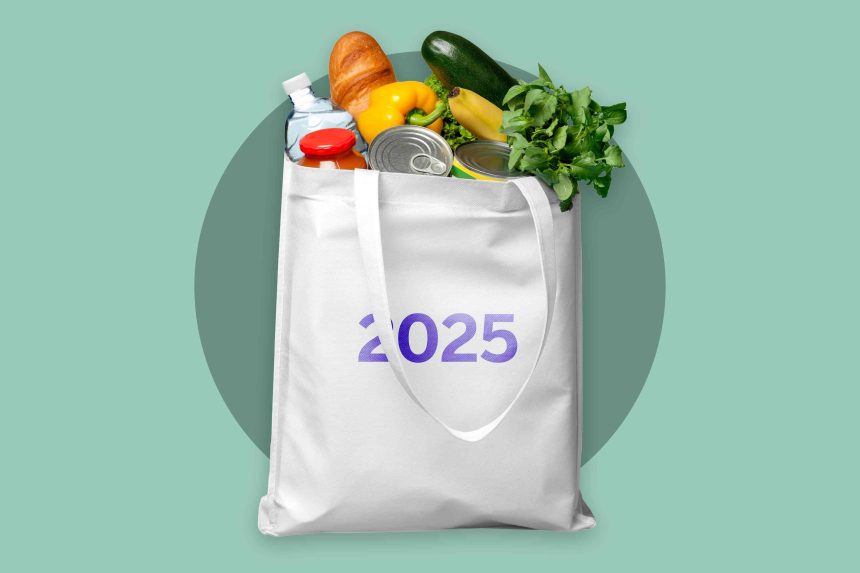Anyone who has shopped for groceries knows that prices have soared this decade. The Bureau of Labor Statistics estimates that prices have risen 28% in the past five years, with some items, such as eggs, increasing even more.
This surge in prices has been a shock for shoppers who were accustomed to moderate inflation and may have never learned how to hunt for bargains. If you fall into that group, here are some tips to help keep your grocery bills in check while still preparing delicious meals at home.
By applying these strategies, you can navigate rising grocery prices without sacrificing quality or variety in your meals. With a little planning, smart shopping habits, and awareness of where your money is going, you can keep your grocery bill under control while still enjoying great food.
Use up what’s in your pantry
The pandemic prompted a significant shift toward cooking at home. With fewer trips to the store, many people stocked up on pantry staples. Now that life has returned to normal, it’s easy to overlook what’s already in your kitchen.
Take an hour to inventory what you have in your cupboards, freezer, refrigerator, storage shelves, or even your home garden. Then, use these ingredients to put meals together before heading to the store. This process not only saves money but also reduces food waste.
Plan your menu in advance
Meal planning may feel tedious or restrictive, but it can be a game-changer for budget-conscious shoppers. Planning menus for a few days or a week helps you use ingredients efficiently and shop strategically.
Focus on meals that yield multiple servings, such as lasagna, pizza, or mac and cheese. Roast vegetables in batches — they can serve as a main dish, a side, or be blended into soup. By planning ahead, you can stretch your groceries further and reduce impulse buys.
Know when buying in bulk doesn’t make sense
If you’re buying for a group or a big family, shopping for multiples can be a good value, especially with warehouse stores like Costco offering tempting bulk deals. However, buying in large quantities isn’t always cost-effective for small households. If you purchase more food than you can reasonably consume, you waste food, which ultimately negates any savings.
Instead, buy smaller amounts that you can use up before they spoil. It’s better to make an extra trip to the store than to throw food (and money) away.
Clip coupons, but be selective
most coupons are for ultra-processed foods like crackers, cookies, and snacks—rarely for fresh produce. If these items align with your eating habits, coupons can be useful. However, if you’re trying to incorporate more fruits and vegetables into your diet, you may find fewer opportunities for savings.
Remember that grocery pickup and delivery can cancel out savings
Relying on grocery pickup services, while convenient, can charge pickup and delivery fees. Over time, these small fees add up and can undo any savings from smart shopping. Grocery delivery can also come with hidden costs. Many stores require a minimum purchase amount — Target, for example, has a $35 minimum for free delivery. If you only need a few items, you might find yourself adding unnecessary extras just to qualify. Before opting for these services, consider whether the convenience is worth the additional expense.
Switch stores when it makes sense
Many shoppers have started switching between grocery stores to find better deals. Some are trading Whole Foods for Aldi, while others are exploring local grocers. Private-label brands can also be a cost-effective alternative.
However, shopping at a new store can be overwhelming until you learn the layout and product selection. Start by trying a few staples, like cereal or snacks, and see if the quality meets your standards. If it does, expand your purchases. If not, reserve your preferred store for certain items and use budget-friendly options for others.
Develop relationships
In the past, my grandmother visited different specialty stores for groceries. My mother recalled how she had a great rapport with her butcher, which sometimes led to getting extra chops or better cuts of meat.
While you don’t need to flirt with your fishmonger, being a loyal customer can have its benefits. Regular shoppers may receive perks like discounts or insider tips on upcoming sales. Don’t hesitate to mention that you’re trying to save money — store employees may offer suggestions on cheaper alternatives or budget-friendly recipes. And remember, store owners would rather see you buy steadily and regularly than swoop in once and demand a deal.
Additionally, consider paying with cash when possible. It helps small businesses avoid credit card processing fees, which can eat into their profits.
Patronize farmers’ markets
By March and April, early produce begins appearing at farmers markets in northern regions, while markets in the South and West are in full swing. While prices at farmers’ markets have risen in recent years, there are still ways to save.
One strategy is to shop toward the end of the market day. Vendors often prefer to sell items at a discount rather than take them home. If you’re buying in bulk to can tomatoes or make applesauce, consider purchasing “seconds” (produce with minor blemishes) for a lower price—just check for deep bruises or spoilage first.
Another tip is to buy at the tail end of a growing season. Early in the season, demand for fresh corn or zucchini is high, but by the end, people have had their fill. This is when farmers may offer discounts to clear out remaining stock. However, as always, only buy what you can reasonably consume.






